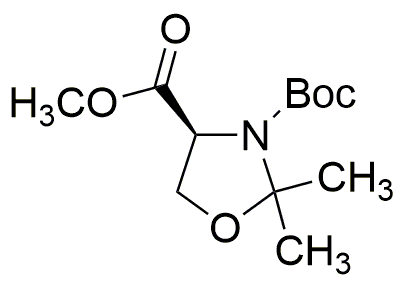(S)-(-)-3-tert-Butoxycarbonyl-4-methoxycarbonyl-2,2-dimethyl-1,3-oxazolidine is widely utilized in research focused on:
- Pharmaceutical Development: This compound serves as an important intermediate in the synthesis of various pharmaceuticals, particularly in the development of drugs that target neurological disorders.
- Peptide Synthesis: It is used in the solid-phase synthesis of peptides, enhancing the efficiency and yield of the process, which is crucial for producing therapeutic proteins.
- Chiral Auxiliary: The compound acts as a chiral auxiliary in asymmetric synthesis, allowing chemists to produce enantiomerically pure compounds, which are vital in drug formulation.
- Research in Organic Chemistry: It provides a versatile framework for the exploration of new synthetic pathways and methodologies, aiding researchers in discovering novel compounds.
- Bioconjugation Techniques: This chemical is employed in bioconjugation strategies, facilitating the attachment of biomolecules to surfaces or other molecules, which is essential in diagnostics and therapeutics.
General Information
Properties
Safety and Regulations
Applications
(S)-(-)-3-tert-Butoxycarbonyl-4-methoxycarbonyl-2,2-dimethyl-1,3-oxazolidine is widely utilized in research focused on:
- Pharmaceutical Development: This compound serves as an important intermediate in the synthesis of various pharmaceuticals, particularly in the development of drugs that target neurological disorders.
- Peptide Synthesis: It is used in the solid-phase synthesis of peptides, enhancing the efficiency and yield of the process, which is crucial for producing therapeutic proteins.
- Chiral Auxiliary: The compound acts as a chiral auxiliary in asymmetric synthesis, allowing chemists to produce enantiomerically pure compounds, which are vital in drug formulation.
- Research in Organic Chemistry: It provides a versatile framework for the exploration of new synthetic pathways and methodologies, aiding researchers in discovering novel compounds.
- Bioconjugation Techniques: This chemical is employed in bioconjugation strategies, facilitating the attachment of biomolecules to surfaces or other molecules, which is essential in diagnostics and therapeutics.
Documents
Safety Data Sheets (SDS)
The SDS provides comprehensive safety information on handling, storage, and disposal of the product.
Product Specification (PS)
The PS provides a comprehensive breakdown of the product’s properties, including chemical composition, physical state, purity, and storage requirements. It also details acceptable quality ranges and the product's intended applications.
Certificates of Analysis (COA)
Search for Certificates of Analysis (COA) by entering the products Lot Number. Lot and Batch Numbers can be found on a product’s label following the words ‘Lot’ or ‘Batch’.
*Catalog Number
*Lot Number
Certificates Of Origin (COO)
This COO confirms the country where the product was manufactured, and also details the materials and components used in it and whether it is derived from natural, synthetic, or other specific sources. This certificate may be required for customs, trade, and regulatory compliance.
*Catalog Number
*Lot Number
Safety Data Sheets (SDS)
The SDS provides comprehensive safety information on handling, storage, and disposal of the product.
DownloadProduct Specification (PS)
The PS provides a comprehensive breakdown of the product’s properties, including chemical composition, physical state, purity, and storage requirements. It also details acceptable quality ranges and the product's intended applications.
DownloadCertificates of Analysis (COA)
Search for Certificates of Analysis (COA) by entering the products Lot Number. Lot and Batch Numbers can be found on a product’s label following the words ‘Lot’ or ‘Batch’.
*Catalog Number
*Lot Number
Certificates Of Origin (COO)
This COO confirms the country where the product was manufactured, and also details the materials and components used in it and whether it is derived from natural, synthetic, or other specific sources. This certificate may be required for customs, trade, and regulatory compliance.


